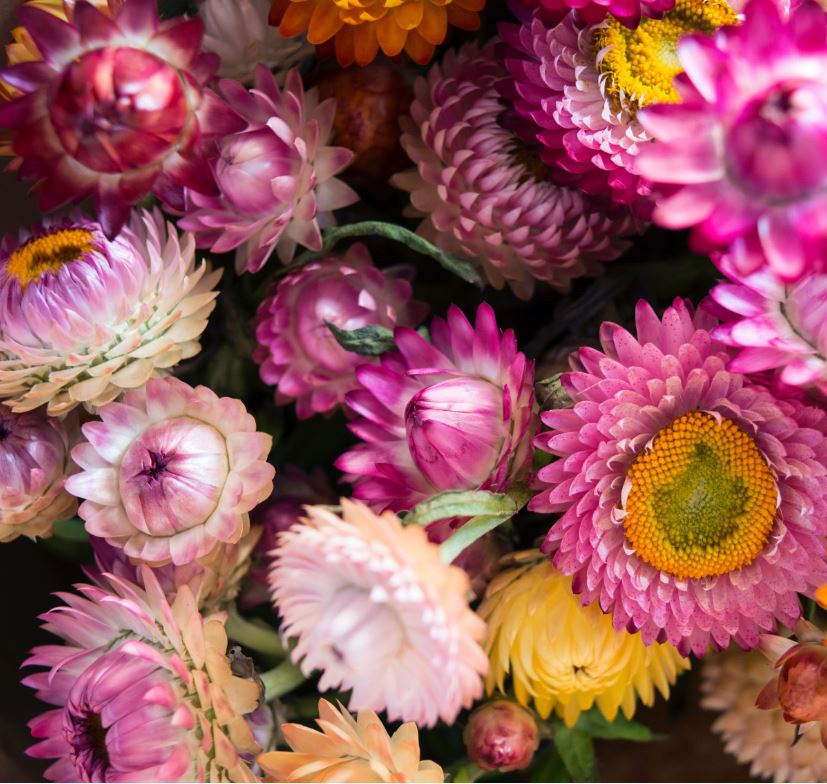Drying your flowers means you can preserve the abundance from your garden to be enjoyed later, when nothing is blooming.
If you use the right method, you can dry just about anything, and there are dozens of books on the subject lining the shelves of used bookstores and thrift stores. One of my favorite and helpful books is, Flowers: Growing, Drying, Preserving, by Alan Cormack and David Carter. This book goes into great detail on all the different varieties you can dry, plus step-by-step instructions for how to do it, whether you’re air-drying or using silica gel. "I personally air dry mine"

There are so many ways to use dried flowers, seedpods, and grasses: in late-autumn arrangements, adorning fresh holiday wreaths, or even mixed with fresh blooms. I thought it would be helpful to share some of the varieties that are the easiest to grow and most popular for drying.

Strawflowers (pictured above) are a traditional standby, but the gorgeous colors and varieties make them incredibly versatile when mixed with fresh blooms.
Start seed indoors in trays 6 weeks before your last frost. Seed requires light to germinate, so do not cover. Bottom-water until seedlings emerge, and transplant out after all danger of frost has passed. For drying, you can cut them at the desired stage of openness and they’ll hold in that stage.

Larkspur is one of the easiest cut flowers to grow—cold tolerant and early to bloom, it adds tall, colorful spikes to spring gardens.
Direct-seed in late fall or early spring or start seed indoors in trays 6 to 8 weeks before your last frost, and plant out while weather is still cool. Plants do best when sown directly in the garden. Larkspur can be planted in fall in even the coldest corners of the world. Speed up germination by chilling seed in a refrigerator or freezer for a week or two before sowing.
To dry, let all but the top 3 to 4 blooms open, then pick and hang upside down in a warm, dark place out of bright light for 2 weeks.

Celosias is grown for their unique textural blooms, they are vigorous and free-flowering. These easy-to-grow flowers come in a wide variety of shapes, colors, and forms, ranging from a crested cockscomb to spikey, plumed forms that are great accents for bouquets.
Flower heads get bigger over time, so pick when they are the size you want, but before they go to seed. Celosias often last 2 weeks as fresh flowers. To dry them, hang freshly cut stems upside down in a warm, dark place for 2 to 3 weeks or until they are firm to the touch.

Gomphrena or Globe amaranth have adorable, button-like blooms that look great in bouquets. This late-summer darling thrives in the heat and is hardworking in both the garden and the vase. I grow 5 different colors but my favorite pop of color has to be is
Start seed indoors in trays 4 to 6 weeks before last frost; transplant out after all danger of frost has passed. Freshly harvested flowers can last up to 2 weeks in the vase, and dried flowers look nearly the same as fresh ones.

With Roses I have found the air-drying method is the best for just opened rosebuds that still have their shape. When air drying flowers should be hanged laundry style with blooms facing the ground as you don’t want gravity working against you. Before hanging flowers, make sure that no water is trapped between petals. For best results dry your flowers in a place that is warm, dark, dry, and has a good ventilation system. Leave them to hang for 2 -3 weeks. If you are drying miniature roses or spray roses you can air dry them by leaving them in a vase. Just don’t forget to empty water from the vase as you don’t want your roses rotting. In hot climates, water will evaporate quickly, so it will not make a difference. Remember to deadhead your roses for more blooms.
Here are a few important things to keep in mind if you’re planning to dry flowers:
- Flowers for drying should be picked more open than those for fresh cuts, but make sure they’re not too ripe. I suggest picking blooms when they are about three-quarters of the way open. If overly ripe, they will fall apart during the drying process.
- After flowers are harvested, you’ll want to remove all of the foliage and leaves on the stem because they will turn brown and crispy when they dry.
- Be sure to hang your bunches upside down while they are drying because the flower heads will be fixed in whatever position they were in when they dried. Hanging them upside down will ensure straight, usable stems.
- Handle dried flowers with care because they are quite fragile and can break easily. If you aren’t going to use them right away, you can wrap them in tissue or kraft paper and store them until needed.
Even if you only save a few bunches of flowers for drying, I’d highly recommend that you give it a try. You’ll be glad to have them on hand during the lean winter months. There are many uses for dried flowers.

One of my favorite gifts to give friends and family is my scented potpourri. When the holiday season rolls around the muted colors and textures take essential oils amazingly add a small sachet to any room and the scent feels like home.
I’d love to hear what you think about dried flowers. Are you drying any flowers from your garden this season? If you’re a dried flower fan, I’d love to know your favorite varieties for drying and any resources that you’d recommend for beginners.
Until next time, Cheers
XO Cheryl

